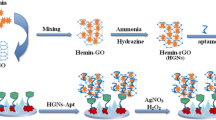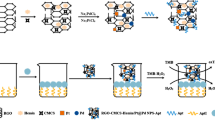Abstract
In this study, a new electrochemical aptasensor with specific identification and quantitative analysis of glypican-3 (GPC3) was constructed using reduced graphene oxide-chitosan-ferrocene deposition of Pt–Pd bimetallic nanoparticles (RGO-CS-Fc/Pt–Pd BNPs) as biosensing platform and GPC3 aptamer (GPC3apt) as recognition molecule. The GPC3apt could react specifically with GPC3 present in the experimental samples, resulting in the formation of GPC3-aptamer complexes on the biosensing platform, which would increase the electron transfer impedance and reduce the redox current of ferrocene. The electrochemical aptasensor was characterized by scanning electron microscopy (SEM), cyclic voltammetry (CV), electrochemical impedance spectrometry (EIS), and Raman spectroscopy. Under the optimal experimental conditions, the response redox current was linearly related to the concentration of GPC3 in the range from 0.001 to 10 µg mL−1 with good linear correlation coefficient (R2 of 0.9929), and had a low detection limit of 3.67 ng mL−1 (S/N = 3), high sensitivity of 0.149 µA µM−1 cm−2. In addition, the aptasensor showed long stability, good specificity, acceptable reproducibility and satisfactory recoveries (101.1–105.6%) in the detection of clinical serum samples, which developed a new research method for early clinical diagnosis.
Graphic abstract







Similar content being viewed by others
References
Fu J, Wang H (2018) Precision diagnosis and treatment of liver cancer in China. Cancer Lett 412:283–288. https://doi.org/10.1016/j.canlet.2017.10.008
Bray F, Ferlay J, Soerjomataram I, Siegel RL, Torre LA, Jemal A (2018) Global cancer statistics 2018: GLOBOCAN estimates of incidence and mortality worldwide for 36 cancers in 185 countries. CA Cancer J Clin 68(6):394–424. https://doi.org/10.3322/caac.21492
Shen Q, Nam SW (2018) SF3B4 as an early-stage diagnostic marker and driver of hepatocellular carcinoma. BMB Rep 51(2):57–58. https://doi.org/10.5483/bmbrep.2018.51.2.021
Grandhi MS, Kim AK, Ronnekleiv-Kelly SM, Kamel IR, Ghasebeh MA, Pawlik TM (2016) Hepatocellular carcinoma: from diagnosis to treatment. Surg Oncol 25(2):74–85. https://doi.org/10.1016/j.suronc.2016.03.002
Sun B, Huang Z, Wang B, Yu YL, Lin SH, Luo L, Wang YZ, Huang Z (2017) Significance of glypican-3 (GPC3) expression in hepatocellular cancer diagnosis. Med Sci Monit 23:850–855. https://doi.org/10.12659/msm.899198
Takahiro N, Hiroaki K (2019) Glypican 3-targeted therapy in hepatocellular carcinoma. Cancers 11(9):1339–1352. https://doi.org/10.3390/cancers11091339
Tahon AM, El-Ghanam MZ, Zaky S, Emran TM, Bersy AM, El-Raey F, Elsayed AZ, El-Kharsawy AM, Johar D (2019) Significance of glypican-3 in early detection of hepatocellular carcinoma in cirrhotic patients. J Gastrointest Cancer 50(3):434–441. https://doi.org/10.1007/s12029-018-0095-2
Montalbano M, Georgiadis J, Masterson AL, McGuire JT, Prajapati J, Shirafkan A, Rastellini C, Cicalese L (2017) Biology and function of glypican-3 as a candidate for early cancerous transformation of hepatocytes in hepatocellular carcinoma (Review). Oncol Rep 37(3):1291–1300. https://doi.org/10.3892/or.2017.5387
Li J, Qiyu S, Wang T, Jin B, Li N (2019) Improving the detection of hepatocellular carcinoma using serum AFP expression in combination with GPC3 and micro-RNA miR-122 expression. Open Life Sci 14(1):53–61. https://doi.org/10.1515/biol-2019-0007
Zhou FB, Shang WT, Yu XL, Tian J (2018) Glypican-3: a promising biomarker for hepatocellular carcinoma diagnosis and treatment. Med Res Rev 38(2):741–767. https://doi.org/10.1002/med.21455
Trung TB, Hung VP, Hoang HT, Tung LM, Lee J (2015) Detection of liver cancer cells by using ELISA and coupling of anti-glypican 3 antibody and magnetite nanoparticles. Geosyst Eng 18(4):219–225. https://doi.org/10.1080/12269328.2015.1070698
Yu JP, Xu XG, Ma RJ, Qin SN, Wang CR, Wang XB, Li M, Li MS, Ma Q, Xu WW (2015) Development of a clinical chemiluminescent immunoassay for serum GPC3 and simultaneous measurements alone with AFP and CK19 in diagnosis of hepatocellular carcinoma. J Clin Lab Anal 29(2):85–93. https://doi.org/10.1002/jcla.21733
Zhang Q, Xiao Q, Lin Z, Ying X, Li Z, Lin JM (2010) Development of a competitive radioimmunoassay for glypican-3 and the clinical application in diagnosis of hepatocellular carcinoma. Clin Biochem 43(12):1003–1008. https://doi.org/10.1016/j.clinbiochem.2010.04.074
Han N, Wang W, Lu D, Wang H, Ma X, Fan X, Li F (2017) A novel, rapid, and sensitive homogeneous sandwich detection method of glypican-3 as a serum marker for hepatocellular carcinoma. Chem Commun 53(90):12209–12212. https://doi.org/10.1039/c7cc06305a
Chikhaliwala P, Rai R, Chandra S (2019) Simultaneous voltammetric immunodetection of alpha-fetoprotein and glypican-3 using a glassy carbon electrode modified with magnetite-conjugated dendrimers. Mikrochim Acta 186(4):255. https://doi.org/10.1007/s00604-019-3354-4
Li GY, Li SS, Wang ZH, Xue YW, Dong CY, Zeng JX, Huang Y, Liang JT, Zhou ZD (2018) Label-free electrochemical aptasensor for detection of alpha-fetoprotein based on AFP-aptamer and thionin/reduced graphene oxide/gold nanoparticles. Anal Biochem 547:37–44. https://doi.org/10.1016/j.ab.2018.02.012
Darmostuk M, Rimpelova S, Gbelcova H, Ruml T (2015) Current approaches in SELEX: an update to aptamer selection technology. Biotechnol Adv 33(6):1141–1161. https://doi.org/10.1016/j.biotechadv.2015.02.008
Zon G (2020) Recent advances in aptamer applications for analytical biochemistry. Anal Biochem. https://doi.org/10.1016/j.ab.2020.113894
Wang X, Zhu Y, Olsen TR, Sun N, Zhang W, Pei R, Lin Q (2018) A graphene aptasensor for biomarker detection in human serum. Electrochim Acta 290:356–363. https://doi.org/10.1016/j.electacta.2018.08.062
Negandary M (2020) Aptamers in nanostructure-based electrochemical biosensors for cardiac biomarkers and cancer biomarkers: a review. Biosens Bioelectron 152:112018–112037. https://doi.org/10.1016/j.bios.2020.112018
Dong LL, Zhou HX, Zhao ML, Gao XH, Liu Y, Liu DL, Guo W, Hu HW, Xie Q, Fan J, Lin J, Wu WZ (2018) Phosphorothioate-modified AP613-1 specifically targets GPC3 when used for hepatocellular carcinoma cell imaging. Mol Ther Nucleic Acids 13:376–386. https://doi.org/10.1016/j.omtn.2018.09.013
Tig GA, Pekyardimci S (2020) An electrochemical sandwich-type aptasensor for determination of lipocalin-2 based on graphene oxide/polymer composite and gold nanoparticles. Talanta 210:120666–120674. https://doi.org/10.1016/j.talanta.2019.120666
Samie HA, Arvand M (2020) Label-free electrochemical aptasensor for progesterone detection in biological fluids. Bioelectrochemistry 133:107489–107489. https://doi.org/10.1016/j.bioelechem.2020.107489
Shi X, Sun J, Yao Y, Liu H, Huang J, Guo Y, Sun X (2020) Novel electrochemical aptasensor with dual signal amplification strategy for detection of acetamiprid. Sci Total Environ 705:135905–135913. https://doi.org/10.1016/j.scitotenv.2019.135905
Divyapriya G, Srinivasan R, Nambi IM, Senthilnathan J (2018) Highly active and stable ferrocene functionalized graphene encapsulated carbon felt array—a novel rotating disc electrode for electro-Fenton oxidation of pharmaceutical compounds. Electrochim Acta 283:858–870. https://doi.org/10.1016/j.electacta.2018.06.186
Fan L, Wang G, Liang W, Yan W, Guo Y, Shuang S, Dong C, Bi Y (2019) Label-free and highly selective electrochemical aptasensor for detection of PCBs based on nickel hexacyanoferrate nanoparticles/reduced graphene oxides hybrids. Biosens Bioelectron 145:111728–111737. https://doi.org/10.1016/j.bios.2019.111728
Shams N, Lim HN, Hajian R, Yusof NA, Abdullah J, Sulaiman Y, Ibrahim I, Huang NM, Pandikumar A (2016) A promising electrochemical sensor based on Au nanoparticles decorated reduced graphene oxide for selective detection of herbicide diuron in natural waters. J Appl Electrochem 46(6):655–666. https://doi.org/10.1007/s10800-016-0950-4
Wang S, Shi Y, Hou Y, Shan S-L, Wang H, Lu J-X (2020) Electrocatalytic asymmetric reduction of ethyl benzoylformate on bimetallic Ag–Cu cathodes. J Appl Electrochem 50(9):973–978. https://doi.org/10.1007/s10800-020-01449-6
Oskueyan G, Mansour Lakouraj M (2019) Electrodeposition of nanostructured Pt–Pd bimetallic catalyst on polyaniline–camphorsulfonic acid/graphene nanocomposites for methanol electrooxidation. J Appl Electrochem 49(8):755–765. https://doi.org/10.1007/s10800-019-01321-2
Bharti A, Rana S, Dahiya D, Agnihotri N, Prabhakar N (2020) An electrochemical aptasensor for analysis of MUC1 using gold platinum bimetallic nanoparticles deposited carboxylated graphene oxide. Anal Chim Acta 1097:186–195. https://doi.org/10.1016/j.aca.2019.11.005
Karthick NA, Thangappan R, Arivanandhan M, Gnanamani A, Jayavel R (2018) A facile synthesis of ferrocene functionalized graphene oxide nanocomposite for electrochemical sensing of lead. J Inorg Organomet Polym Mater 28(3):1021–1028. https://doi.org/10.1007/s10904-017-0744-0
Wei P, Zhu Z, Song R, Li Z, Chen C (2019) An ion-imprinted sensor based on chitosan-graphene oxide composite polymer modified glassy carbon electrode for environmental sensing application. Electrochim Acta 317:93–101. https://doi.org/10.1016/j.electacta.2019.05.136
Del Prado-Audelo ML, Caballero-Florán IH, Sharifi-Rad J, Mendoza-Muñoz N, González-Torres M, Urbán-Morlán Z, Florán B, Cortes H, Leyva-Gómez G (2020) Chitosan-decorated nanoparticles for drug delivery. J Drug Deliv Sci Technol 59:101896–101913. https://doi.org/10.1016/j.jddst.2020.101896
Lambert WT, Buysse AM, Wessels FJ (2020) Discovery of novel insecticidal 3-aminopyridyl ureas. Pest Manag Sci 76(2):497–508. https://doi.org/10.1002/ps.5537
Tamer TM, Valachova K, Hassan MA, Omer AM, El-Shafeey M, Eldin MSM, Soltes L (2018) Chitosan/hyaluronan/edaravone membranes for anti-inflammatory wound dressing: in vitro and in vivo evaluation studies. Mater Sci Eng C 90:227–235. https://doi.org/10.1016/j.msec.2018.04.053
Wang AJ, Zhu XY, Chen Y, Luo X, Xue Y, Feng JJ (2019) Ultrasensitive label-free electrochemical immunoassay of carbohydrate antigen 15-3 using dendritic Au@Pt nanocrystals/ferrocene-grafted-chitosan for efficient signal amplification. Sens Actuators B 292:164–170. https://doi.org/10.1016/j.snb.2019.04.128
Zhao ML, Dong LL, Liu Z, Yang SH, Wu WZ, Lin J (2018) In vivo fluorescence imaging of hepatocellular carcinoma using a novel GPC3-specific aptamer probe. Quant Imaging Med Surg 8(2):151–160. https://doi.org/10.21037/qims.2018.01.09
Li GY, Zeng JX, Zhao L, Wang ZH, Dong CY, Liang JT, Zhou ZD, Huang Y (2019) Amperometric cholesterol biosensor based on reduction graphene oxide-chitosan-ferrocene/platinum nanoparticles modified screen-printed electrode. J Nanopart Res 21(7):162–178. https://doi.org/10.1007/s11051-019-4602-6
Yang S, Zhang F, Wang Z, Liang Q (2018) A graphene oxide-based label-free electrochemical aptasensor for the detection of alpha-fetoprotein. Biosens Bioelectron 112:186–192. https://doi.org/10.1016/j.bios.2018.04.026
Wang L, Zhang Y, Cheng C, Liu X, Jiang H, Wang X (2015) Highly sensitive electrochemical biosensor for evaluation of oxidative stress based on the nanointerface of graphene nanocomposites blended with gold, Fe3O4, and platinum nanoparticles. ACS Appl Mater Interfaces 7(33):18441–18449. https://doi.org/10.1021/acsami.5b04553
Huang Y, Cui L, Xue Y, Zhang S, Zhu N, Liang J, Li G (2017) Ultrasensitive cholesterol biosensor based on enzymatic silver deposition on gold nanoparticles modified screen-printed carbon electrode. Mater Sci Eng C 77:1–8. https://doi.org/10.1016/j.msec.2017.03.253
Lee CS, Yu SH, Kim TH (2017) One-step electrochemical fabrication of reduced graphene oxide/gold nanoparticles nanocomposite-modified electrode for simultaneous detection of dopamine, ascorbic acid, and uric acid. Nanomaterials (Basel) 8(1):17–30. https://doi.org/10.3390/nano8010017
Chen JJ, Xie CM, Wang CR, Wan Y, Dong ZN, Li M, Xu WW (2017) Development of a time-resolved fluorescence immunoassay for the diagnosis of hepatocellular carcinoma based on the detection of glypican-3. J Fluoresc 27(4):1479–1485. https://doi.org/10.1007/s10895-017-2087-1
Xie CM, Tiede C, Zhang XY, Wang CR, Li ZX, Xu X, McPherson MJ, Tomlinson DC, Xu WW (2017) Development of an affimer antibody combined immunological diagnosis kit for glypican-3. Sci Rep. https://doi.org/10.1038/s41598-017-10083-w
Ma XY, Wang XL, Chen MF, Li FC (2017) Study on a new high affinity anti-glypicans-3 antibody in diagnosis of early hepatocellular carcinoma by differential pulse voltammetry. J Solid State Electrochem 21(6):1631–1637. https://doi.org/10.1007/s10008-017-3535-1
Acknowledgements
This work was supported by the National Nature Science Foundation of China (Nos. 81760534 and 61941108), the Fund of Guangxi Key Laboratory of Metabolic Diseases Research (No. 20-065-76), the National Science Foundation of Guangxi Province of China (No. 2020GXNSFAA159161) and the Innovation Project of GUET Graduate Education (No. 2020YCXS131).
Author information
Authors and Affiliations
Corresponding authors
Ethics declarations
Conflict of interest
The authors declare that they have no known competing financial interests or personal relationships in this work.
Ethical approval
The human serum samples used in this study were approved by the Guangxi Key Laboratory of Metabolic Diseases Research Ethics Committee in Guilin, China.
Additional information
Publisher’s note
Springer Nature remains neutral with regard to jurisdictional claims in published maps and institutional affiliations.
Electronic supplementary material
Below is the link to the electronic supplementary material.
Rights and permissions
About this article
Cite this article
Shi, X., Chen, M., Feng, H. et al. Glypican-3 electrochemical aptasensor based on reduced graphene oxide‐chitosan‐ferrocene deposition of platinum–palladium bimetallic nanoparticles. J Appl Electrochem 51, 781–794 (2021). https://doi.org/10.1007/s10800-021-01534-4
Received:
Accepted:
Published:
Issue Date:
DOI: https://doi.org/10.1007/s10800-021-01534-4




